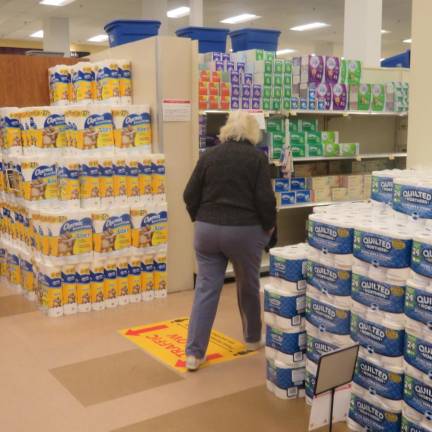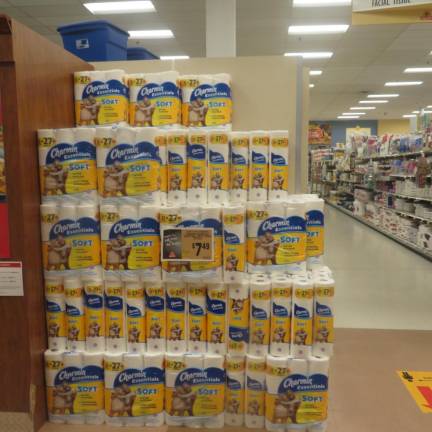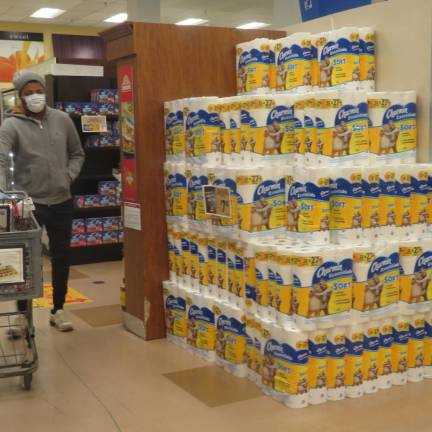Store manager: ‘Please buy only what you need’
Shopping. Stress can trigger our ancient brain’s instinct to Get more now! But experts say panic buying is counterproductive.



Toilet paper, bottled water, flour, yeast, cleaning supplies, meat.
“All the canned goods. From A to Z, they were just buying things, to have,” said Junior Dabashi, manager of Key Foods in Milford, Pa.
As the pandemic runs its course, our panic-buying is not only reflecting our anxieties du jour – it’s also causing some of the very problems we fear.
You’d be crazy not to be worried right now, Dabashi acknowledged. “It’s a new thing for everyone," he said. "I understand they do panic, but I do think they could give us a chance to try to serve and help them. You can’t just buy your way out of here, just come into the store and just buy everything. The poor 90-year-old person that needs one pound of ground beef can’t get it because you bought the whole freakin’ shelf.”
The official recommendation from the U.S. Department of Agriculture is to keep two weeks of food in the house during the pandemic, a mix of fresh, frozen, and shelf-stable food. Some people, fearing shortages and the unknown, have been squirreling away many times more than that, setting into motion a vicious cycle.
At the height of the hoarding in late March, customers who usually shop for a week’s groceries were buying six weeks’ worth, then returning a couple days later to do it again, said Dabashi. He took to hiding toilet paper and paper towels to keep aside for his elderly regulars.
Beyond the un-neighborliness of leaving none for the next guy, hoarding is counterproductive – and highly contagious, said John Sterman, professor of system dynamics and engineering systems at MIT Sloan School of Management. The compounding effect of our panic-buying can actually create the shortage we feared, turning our fear into a self-fulfilling prophesy. Sterman is lead author of the 2015 study, "I’m not hoarding, I’m just stocking up before the hoarders get here."
Slowing the runaway train
Like grocery stores all over, Dabashi had to impose limits on items like meat, toilet paper, water, and yeast. (This can backfire, as nothing stokes desire like those “two per customer” signs.) All of those were back in stock with no limits as of early May, though “not the actual good brands – generic,” said Dabashi. Except yeast, which he still can’t get.
Dabashi’s attempts to slow the runaway train included posting videos to Key Food’s Facebook page in late March. One shows a truck making a delivery while he says, looking and sounding like an exhausted parent, “We have dairy and produce trucks, meat, deli started showing up – but it’s still limited supplies, so once again please buy only what you need, and give a chance to others to buy what they need, all right?”
In another, he beseeches shoppers to be kind to employees: “It’s not their fault that the trucks are late or that there are shortages from the warehouses.”
The hoarding frenzy had calmed down by early May. “I think everybody realized they don’t need all the stuff, and it’s piling up in the house,” said Dabashi.
Then again, the relative calm might also be the eye of the storm. On May 6, Dabashi was bracing for the meat shortage to trickle down to his store within the week, especially red meat and pork. “I think a lot of the warehouses are closing down because some of the employees got sick,” he said. “As of now, we do have everything, but some of the prices are high.”
Many who can afford the upcharge have switched to having their groceries delivered. Others, suddenly unemployed, can’t afford to go to the store and are going hungry in record numbers. For everyone else, grocery shopping has become a doubly stressful experience: on top of the fear of shortages, there’s the growing fear of getting sick – getting sneezed or coughed on, or touching a surface that harbors the virus. Others aren’t worried about that, and that friction is increasingly charged, too.
“Some people don’t care that there’s a virus,” said Dabashi. “If you don’t care, other people do. I had to kick some people out of here because they don’t have a mask.”
One customer was so upset that a man who just walked in wasn’t wearing a mask, that she demanded – and got – a full refund for all the food she had just purchased.
Our 'deeply embedded scarcity response'
Shopping in this anxiety-inducing atmosphere, our emotional brain can dominate our executive decision-making, said Sterman. “The ancient part of your brain that reacts to these stimuli is saying, You know, There’s not enough! Other people are getting it! Get more now! Those are very powerful signals,” said Sterman. “There’s this deeply embedded scarcity response baked into the ancient part of our brain,” which evolved in a world where there was no guarantee you would have a next meal. “But those are inappropriate today.”
While understandable, panic buying is “counterproductive for everyone,” he said. “Nobody needs 200 rolls of toilet paper in their house, and nobody needs to be buying so much food, especially perishable food.” Historically, at times like this when food prices spike or there’s a rumor of scarcity, food waste actually goes up, said Sterman, since people can’t eat all the food they’ve bought before it goes bad.
“We have the products, we have everything,” Dabashi reassured. “We don’t have as much of a lot of things, but we have everything. Don’t overdo it,” he said. “You don’t need to buy 10 to 20 things of one kind.”
In some cases, as with toilet paper – whose consumption remains exactly the same as before the pandemic, with no interruptions to the supply chain – there’s no logic behind the hoarding. It just feeds on itself. Seeing empty shelves, everyone rushes out to stock up, grocery stores place bigger orders, their suppliers can't fill them, and we have the shortage we dreaded.
“Now you can get it anytime, anywhere,” said Sterman, of toilet paper. “That’s the evidence. That’s going to be true across the board. It’ll take a little longer for things like eggs and milk and meat." With eggs, milk and meat, those systems are actually experiencing shocks to the supply chain, like the well-publicized closure of the Smithfield and Tyson plants.
Meat shortages and price fluctuations could last until mid-June at least, said Erin Coventry, manager of Prime Time Meats in Milford, Pa. But we are not going to run out of meat altogether.
“When one plant closes, another opens,” she said. “As long as we stay ahead on buying, we will continue to have product. However, there will be certain things we can’t carry due to price and shortages.”
Stay flexible
The important thing to remember, said Sterman, is that these shortages are temporary. Hens are still laying, cows are being milked, and hogs are fattening. Meanwhile, our food consumption is essentially the same (save for a little stress eating).
The processing plants will come back online, said Sterman, as they figure out how to run them safely, with protective gear and worker distancing. “There isn’t any underlying shortage of food in the United States,” he said. “So the best thing people can do is relax and not worry about it,” and buy only what you need to replace what you’re actually using.
“I don’t envision that we are going to face a time that we go to the store and the shelves will be empty by any stretch of the imagination,” said Dana Gunders, executive director of ReFed, a nonprofit that works across the food industry to reduce food waste. When it comes to specific products whose supply chains are struggling, like meat, “You may not be able to get every cut when you go to the store,” she said. But it’s not a situation that warrants hoarding, which only makes it worse. Frozen meat will still be available, she said, because the meat industry keeps stockpiles.
Instead of panicking, now is a time to be flexible: expand your cooking repertoire, broaden your palette, or eat a little less meat, suggests Gunders. Think about using “half the amount of meat you might normally in a lasagna or pasta sauce,” she said. “Beans are a really filling, healthy, and affordable way to make a meal feel like a meal.” The USDA tip sheet suggests making your grocery list with general items like “bread” and “fruit,” since stores may not have every item or all the usual brands.
While we’re home, feeding our families three meals a day, it’s an opportunity to focus on our food management skills too, said Gunders. “We’re hearing a lot in the news right now about farms having to leave food unharvested and such, but actually we in our homes are able to make a really big dent in this problem,” she said. “It’s a great time to also see how you can do in not wasting a lot of food -- using leftovers, finding recipes that can use up all the bits of ingredients you have in your fridge for a meal.”
"I understand they do panic, but I do think they could give us a chance to try to serve and help them. You can’t just buy your way out of here, just come into the store and just buy everything. The poor 90-year-old person that needs one pound of ground beef can’t get it because you bought the whole freakin’ shelf.” --Junior Dabashi, Key Foods